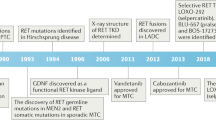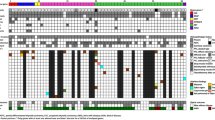Abstract
We have analysed 118 families with inherited medullary thyroid carcinoma (MTC) for mutations of the RET proto–oncogene. These included cases of multiple endocrine neoplasia types 2A (MEN 2A) and 2B (MEN 2B) and familial MTC (FMTC). Mutations at one of 5 cysteines in the extracellular domain were found in 97% of patients with MEN 2A and 86% with FMTC but not in MEN 2B patients or normal controls. 84% of the MEN2A mutations affected codon 634. MEN 2A patients with a Cys634 to Arg substitution had a greater risk of developing parathyroid disease than those with other codon 634 mutations. Our data show a strong correlation between disease phenotype and the nature and position of the RET mutation, suggesting that a simple, constitutive activation of the RET tyrosine kinase is unlikely to explain the events leading to MEN 2A and FMTC.
This is a preview of subscription content, access via your institution
Access options
Subscribe to this journal
Receive 12 print issues and online access
$209.00 per year
only $17.42 per issue
Buy this article
- Purchase on Springer Link
- Instant access to full article PDF
Prices may be subject to local taxes which are calculated during checkout
Similar content being viewed by others
References
Schimke, R.N. Genetic aspects of multiple endocrine neoplasia. Ann. Rev. Med. 35, 25–31 (1984).
Farndon, J.R. et al. Familial medullary thyroid carcinoma without associated endocrinopathies: a distinct clinical entity. Br. J. Surg. 73, 278–281 (1986).
Gardner, E. et al. Genetic linkage studies map the multiple endocrine neoplasia type 2 loci to a small interval on chromosome 10q11.2. Hum. molec. Genet. 2, 241–246 (1993).
Lairmore, T.C. et al. Familial medullary thyroid carcinoma and multiple endocrine neoplasia type 2B map to the same region of chromosome 10 as multiple endocrine neoplasia type 2A. Genomics 9, 181–192 (1991).
Norum, R.A. et al. Linkage of the multiple endocrine neoplasia type 2B gene (MEN2B) to chromosome 10 markers linked to MEN2A. Genomics 8, 313–317 (1990).
Mole, S.E., Mulligan, L.M., Healey, C.S., Ponder, B.A.J. & Tunnacliffe, A. Localisation of the gene for multiple endocrine neoplasia type 2A to a 480 kb region in chromosome band 10q11.2. Hum. molec. Genet. 2, 247–252 (1993).
Lairmore, T.C. et al. A 1.5-megabase yeast artificial chromosome contig from human chromosome 10q11.2 connecting three genetic loci (RET, D10S94 and D10S102) closely linked to the MEN2A locus. Proc. natn. Acad. So. U.S.A 90, 492–496 (1993).
Miya, A. et al. Expression of the ret proto-oncogene in human medullary thyroid carcinomas and pheochromocytomas of MEN2A. Henry Ford Hosp. Med. J. 40, 215–219 (1992).
Santoro, M. et al. The RET proto–oncogene is consistently expressed in human pheochromocytomas and thyroid medullary carcinomas. Oncogene 5, 1595–1598 (1990).
Mulligan, L.M. et al. Germ-line mutations of the RET proto-oncogene in multiple endocrine neoplasia type 2A. Nature 363, 458–460 (1993).
Kwok, J.B.J., Gardner, E., Warner, J.P., Ponder, B.A.J. & Mulligan, L.M. Structural analysis of the human ret proto-oncogene using exon trapping. Oncogene 8, 2575–2582 (1993).
Donis-Keller, H. et al. Mutations In the RET proto-oncogene are associated with MEN 2A and FMTC. Hum. molec. Genet. 2, 851–856 (1993).
Takahashi, M. et al. Cloning and expression of the ret proto-oncogene encoding a tyrosine kinase with two potential transmembrane domains. Oncogene 3, 571–578 (1988).
Takahashi, M., Buma, Y. & Hiai, H. Isolation of ret proto-oncogene cDNA with an amino-terminal signal. Oncogene 4, 805–806 (1989).
Iwamoto, T. et al. cDNA cloning of mouse ret proto-oncogene and its sequence similarity to the cadherin superfamily. Oncogene 8, 1087–1091 (1993).
Thakker, R.V. & Ponder, B.A.J. Multiple endocrine neoplasia In Clinical Endocrinology and Metabolism Vol. 2 (ed. Sheppard, M.C.) 1031–1067 (Bailliere Tindall, London, (1988).
Gagel, R.F. et al. The clinical outcome of prospective screening for multiple endocrine neoplasia type 2A. New Engl. J. Med. 318, 478–484 (1988).
La Spada, A.R., Wilson, E.M., Lubahn, D.B., Harding, A.E. & Fishbeck, K.H. Androgen receptor gene mutations in X-linked spinal and bulbar muscular atrophy. Nature 352, 77–79 (1991).
Tsui. L.C. The spectrum of cystic flbrosis mutations. Trends Genet. 8, 392–398 (1992).
Anguiano, A. et al. Congenital bilateral absence of the vas deferens. J. Am. med. Assoc. 267, 1794–1797 (1992).
Mathew, C.G.P. et al. Deletion of genes on chromosome 1 in endocrine neoplasia. Nature 328, 524–526 (1987).
Itoh, F. et al. Identification and analysis of the ret proto-oncogene promoter region in neuroblastoma cell lines and medullary thyroid carcinomas from MEN2A patients. Oncogene 7, 1201–1206 (1992).
Author information
Authors and Affiliations
Rights and permissions
About this article
Cite this article
Mulligan, L., Eng, C., Healey, C. et al. Specific mutations of the RET proto-oncogene are related to disease phenotype in MEN 2A and FMTC. Nat Genet 6, 70–74 (1994). https://doi.org/10.1038/ng0194-70
Received:
Accepted:
Issue Date:
DOI: https://doi.org/10.1038/ng0194-70
This article is cited by
-
The SLC6A19 gene mutation in a young man with hyperglycinuria and nephrolithiasis: a case report and literature review
BMC Urology (2022)
-
The importance of the RET gene in thyroid cancer and therapeutic implications
Nature Reviews Endocrinology (2021)
-
Retroposed copies of RET gene: a somatically acquired event in medullary thyroid carcinoma
BMC Medical Genomics (2019)
-
Association of medullary sponge kidney and hyperparathyroidism with RET G691S/S904S polymorphism: a case report
Journal of Medical Case Reports (2018)
-
Targeting RET-driven cancers: lessons from evolving preclinical and clinical landscapes
Nature Reviews Clinical Oncology (2018)



